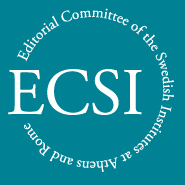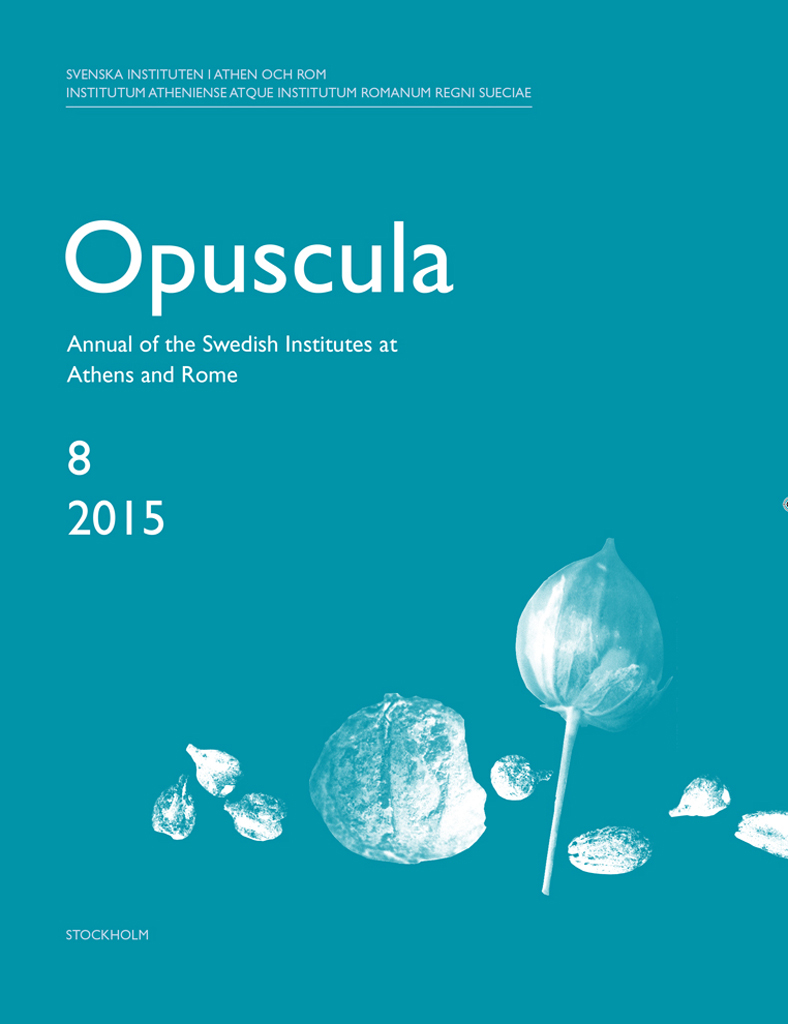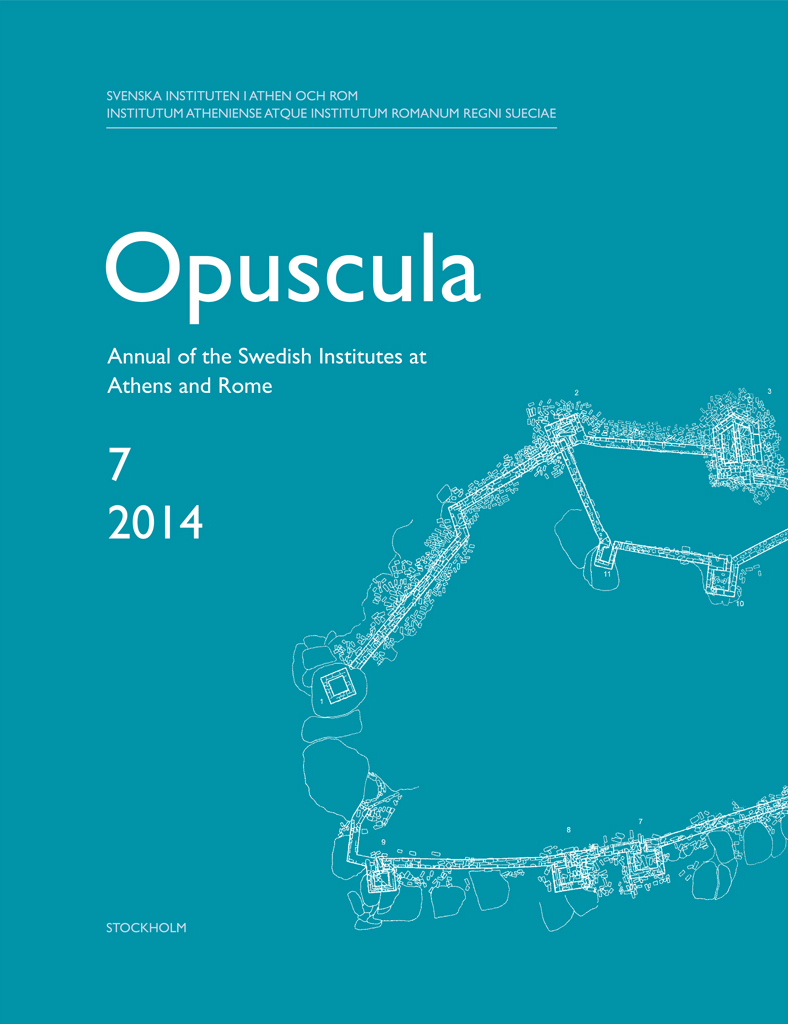Opuscula is published by the Swedish Institutes at Athens and Rome, with the aid of a grant from the Swedish Research Council. Distributed by Eddy.se AB. View journal at ERIH PLUS. All content available with open access. Later, laterculus, and testa. New perspectives on Latin brick terminology By Henrik Gerding Abstract For centuries antiquarians and archaeologists have tried to reconcile the terminology of ancient writers on architecture, such as Vitruvius, with the perceived realities of the material record. One particular issue of debate concerns the interpretation of different words for “brick” in Latin. In this paper it is argued that earlier attempts to settle this question are unsatisfactory and leave several problems unresolved. A thorough examination of literary and epigraphic sources, combined with new insights in Hellenistic brick usage, suggests that primary distinctions in Latin brick terminology were based on shape and size, rather than on a mere division between fired and unfired bricks. Thus, it is argued that later basically signified a large moulded block, but normally was used to indicate mud bricks; that laterculus changed over time from being a diminutive (a small later) to becoming the standard term for the relatively thin fired bricks of the Roman…
Opuscula is published by the Swedish Institutes at Athens and Rome, with the aid of a grant from the Swedish Research Council. Distributed by Eddy.se AB. View journal at ERIH PLUS. All content available with open access. Book reviews Anton Bonnier | E. Mackil, Creating a common polity. Religion, economy, and politics in the making of the Greek koinon (Hellenistic Culture and Society, 55), Berkeley, Los Angeles & London, University of California Press 2013, xvii + 593 pp. ISBN 9780520272507. https://doi.org/10.30549/opathrom-08-09 Maria Mili | I. Polinskaya, A local history of Greek polytheism: Gods, people and the land of Aigina 800–400 BC (Religions in the Ancient Greek World, 178), Leiden, Brill 2013, xxviii + 690 pp. ISBN 978-90-04-23404-8. https://doi.org/10.30549/opathrom-08-10 David Westberg | P. Ceccarelli, Ancient Greek letter writing: A cultural history (600 BC–150 BC), Oxford, Oxford University Press 2013, xviii + 435 pp. ISBN 978-0-19-967559-3. https://doi.org/10.30549/opathrom-08-11 Otto Linderborg | E. Carawan, The Athenian amnesty and reconstructing the law. Oxford, Oxford University Press 2013, 310 pp. ISBN 978-0-19-967276-9. https://doi.org/10.30549/opathrom-08-12 Adam J. Goldwyn | Daughters of Hecate: Women and magic in the ancient world, ed. K. B. Stratton with D.S. Kalleres, Oxford: Oxford University Press 2014. 552 pp. ISBN 0-19-534271-2. https://doi.org/10.30549/opathrom-08-13 Bibliographical information…
Opuscula is published by the Swedish Institutes at Athens and Rome, with the aid of a grant from the Swedish Research Council. Distributed by Eddy.se AB. View journal at ERIH PLUS. All content available with open access. Terenz’ Hecyra—Spiel der Voreiligkeiten By Gregor Maurach Abstract Rashness was one of the most urgent themes and most poignant reproaches in Greek experience and reasoning from the 5th century BC onwards: Thucydides complained of rash actions during the Peloponnesian War that led to disaster; Sophocles showed Deianeira rashly sending the lethal garment to her husband on his return with Iole, and Plato made his Socrates expose the rashness of his interlocutors’ assertions again and again. Small wonder, then that Comedy, especially the New Comedy, seized upon this all-pervading deficiency, as can be seen for example in Menander’s Perikeiromene and Epitrepontes, where impulsive young men nearly destroy their lives by acting and judging precipitately. Roman Comedy naturally followed suit, for example Terence in Heautontimorumenos as well as in his Hecyra, where he followed Apollodorus: time and again his characters assert what they do not know for certain and time and again they act according to unwarranted assumptions, a pivotal theme that hitherto seems to…
Opuscula is published by the Swedish Institutes at Athens and Rome, with the aid of a grant from the Swedish Research Council. Distributed by Eddy.se AB. View journal at ERIH PLUS. All content available with open access. The Swedish Jordan Expedition 2014 at Tall Abu al-Kharaz. Preliminary results from Areas 12 and 13 By Peter M. Fischer & Teresa Bürge Abstract In previous seasons excavations have concentrated on the periphery of the city of Tall Abu al-Kharaz, a multi-period tell in the Central Jordan Valley. Tall Abu al-Kharaz flourished from the Early Bronze to Islamic times, from roughly 3200 BC to the 10th century AD. The main object of the field work in 2014 was to investigate the area around the geographical centre of the city (Area 12). Preference was given to further investigation of the Iron Age sequence, i.e. the period from the 12th to the 7th centuries BC (local Phases IX–XV). Another task was to extend the excavations in the northern part of the city, Area 7, which produced essential information on the Iron Age, towards the south (Area 13) in order to generate a coherent picture of Iron Age occupation in the city’s northern half. Domestic structures…
Opuscula is published by the Swedish Institutes at Athens and Rome, with the aid of a grant from the Swedish Research Council. Distributed by Eddy.se AB. View journal at ERIH PLUS. All content available with open access. Loom weights in Archaic South Italy and Sicily: Five case studies By Hedvig Landenius Enegren Abstract Textiles are perishables in the archaeological record unless specific environmental conditions are met. Fortunately, the textile tools used in their manufacture can provide a wealth of information and via experimental archaeology make visible to an extent what has been lost. The article presents and discusses the results obtained in a research project focused on textile tool technologies and identities in the context of settler and indigenous peoples, at select archaeological sites in South Italy and Sicily in the Archaic and Early Classical periods, with an emphasis on loom weights. Despite a common functional tool technology, the examined loom weights reveal an intriguing inter-site specificity, which, it is argued, is the result of hybrid expressions embedded in local traditions. Experimental archaeology testing is applied in the interpretation of the functional qualities of this common artefact. Bibliographical information Hedvig Landenius Enegren, ‘Loom weights in Archaic South Italy and Sicily:…
Opuscula is published by the Swedish Institutes at Athens and Rome, with the aid of a grant from the Swedish Research Council. Distributed by Eddy.se AB. View journal at ERIH PLUS. All content available with open access. Cutting the Gordian knot. The iconography of Megaron 2 at Gordion By Susanne Berndt Abstract This article examines the incised drawings of Early Phrygian Gordion, and in particular those of Megaron 2. Aspects of their iconographic and archaeological contexts are taken in to consideration, as well as literary sources and especially the story of the Gordian knot. The focus of the study is a series of incised labyrinths, which have hitherto not been recognized as such, but which are of particular interest for the analysis of this building. The myth of Theseus and the Minotaur in the labyrinth helps to throw light on both the images of Megaron 2 but also on the story of the Gordion knot, and how these are interlinked with each other. It is suggested that Ariadne’s ball of thread and the Gordian knot are two different expressions of a similar concept; both represent sovereignty provided by a Goddess. Megaron 2 seems to have been a building that was…
Opuscula is published by the Swedish Institutes at Athens and Rome, with the aid of a grant from the Swedish Research Council. Distributed by Eddy.se AB. View journal at ERIH PLUS. All content available with open access. Two new Proto-White Painted ware vases of the pictorial style from Palaepaphos, Cyprus By Vassos Karageorghis & Efstathios Raptou Abstract The publication of two Proto-White Painted ware pictorial style vases found at the necropolis of Palaepaphos-Skales in Cyprus is preceded by a discussion of several issues relating to this style which appeared early in the 11th century BC. In recent years scholars have expressed conflicting views about the origin of the silhouetted pictorial motifs (birds, quadrupeds, human figures etc.), which appear next to the linear geometric decoration on such vases, usually amphorae and kraters. Some have expressed the view that the influence comes from Syria. Here it is proposed that the silhouetted figures of Proto-White Painted ware are derived from a Cypriote style with both local and Aegean characteristics, which developed in the 12th century BC. The pictorial motifs of this style, drawn both in outline and silhouette, are combined with linear geometric motifs, also in panels. In Proto-White Painted ware the pictorial…
Opuscula is published by the Swedish Institutes at Athens and Rome, with the aid of a grant from the Swedish Research Council. Distributed by Eddy.se AB. View journal at ERIH PLUS. All content available with open access. The New Swedish Cyprus Expedition 2014. Excavations at Hala Sultan Tekke. Preliminary results. By Peter M. Fischer & Teresa Bürge. With contributions by B. Stolle, I. Trinks, L. Mazzotta, L. Recht, A. Lindqvist & D. Kofel. Abstract The initial aim of the project—the search for the oldest city of Hala Sultan Tekke—continued in 2014. Geophysical methods were used, which led to the discovery of new city quarters, and a broadening of the research objectives, to include revealing the total extent of the city. The GPR survey indicated a huge stone compound of at least 50 m × 40 m to the west of a probable street. Excavations continued in Area 6 West, where in 2013 a domestic and industrial compound was excavated as part of a hitherto unknown city quarter. The 2014 field work exposed stone-built structures and rich find contexts with locally made and imported pottery, numerous tools and several items of gold and silver jewellery. The violent destruction of the most…
Opuscula is published by the Swedish Institutes at Athens and Rome, with the aid of a grant from the Swedish Research Council. Distributed by Eddy.se AB. View journal at ERIH PLUS. All content available with open access. The Charitonidis Class: A group of large Athenian Late Protogeometric skyphoi By John K. Papadopoulos Abstract This article assembles and publishes a group of distinctive large Athenian Late Protogeometric skyphoi. Aspects of shape and decoration are fully discussed, so too the evidence for establishing the date of the group, as well as their distribution. The group, if not the potter, is named after the man who published two complete examples of the class from the South Slope of the Athenian Acropolis: Serapheim Charitonidis. Bibliographical information John K. Papadopoulos, ‘The Charitonidis Class: A group of large Athenian Late Protogeometric skyphoi’, Opuscula. Annual of the Swedish Institutes at Athens and Rome (OpAthRom) 8, Stockholm 2015, 7–26. ISSN: 2000-0898. ISBN: 978-91-977798-7-6. https://doi.org/10.30549/opathrom-08-02
Opuscula is published by the Swedish Institutes at Athens and Rome, with the aid of a grant from the Swedish Research Council. Distributed by Eddy.se AB. View journal at ERIH PLUS. All content available with open access. Book reviews Kristian Göransson | G. Ceserani, Italy’s lost Greece: Magna Graecia and the making of modern archaeology, Oxford: Oxford University Press 2012. 352 pp. ISBN 978-0-19-974427-5 & J. Arthurs, Excavating modernity: The Roman past in Fascist Italy, Ithaca & London: Cornell University Press 2012. 232 pp. ISBN 978-0-8014-4998-7. https://doi.org/10.30549/opathrom-07-14 Örjan Wikander | R. Spain, The power and performance of Roman watermills. Hydro-mechanical analysis of vertical-wheeled watermills (BAR-IS, 1786). Oxford: Archaeopress 2008, xiv + 107 pp. ISBN 978-1-4073-0217-1. https://doi.org/10.30549/opathrom-07-15 Gullög Nordquist | T.F. Tartaron, Maritime networks in the Mycenaean world. Cambridge: Cambridge University Press 2013. ISBN 978-1-107-00298-2. https://doi.org/10.30549/opathrom-07-16 Julia Habetzeder | Kunst von unten? Stil und Gesellschaft in der antiken Welt von der »arte plebea« bis heute (Palilia, 27), eds. F. de Angelis, J.-A. Dickmann, F. Pirson and R. von den Hoff, Deutsches Archäologisches Institut Rom. Wiesbaden 2012. 184 pp. ISBN 978-3-89500-915-0. https://doi.org/10.30549/opathrom-07-17 P.J. Rhodes | C.H. Lyttkens, Economic analysis of institutional change in Ancient Greece: Politics, taxation and rational behaviour (Routledge Explorations…



